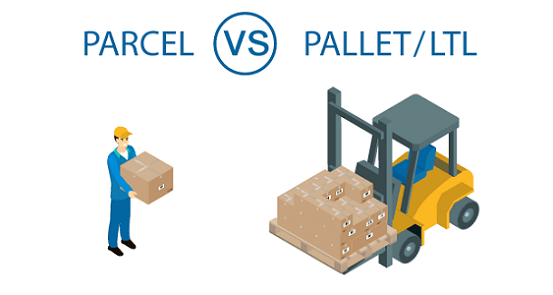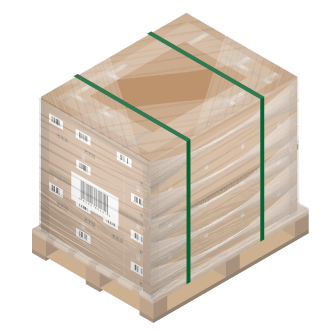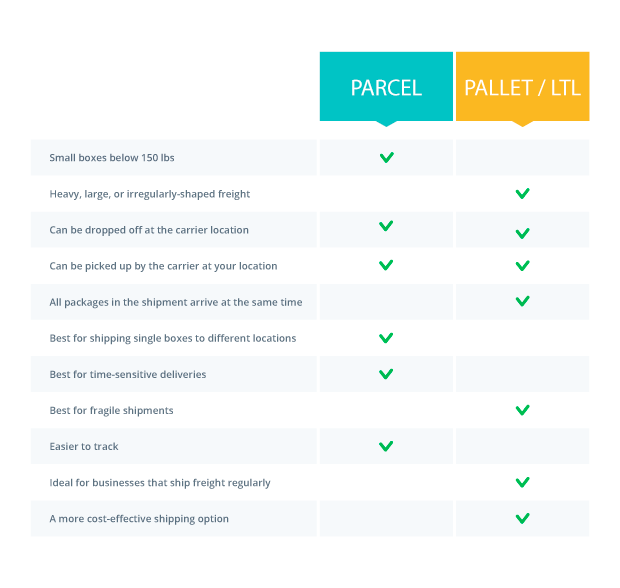Parcel vs. Pallet Shipping: Which One to Choose?

Does Your Shipment Require a Freight Carrier or a Parcel Courier? You’re About to Find Out!
[Updated April 2024]
We often get questions from our customers regarding which shipping option they should choose for their business: parcel shipping or pallet shipping. These two options are actually quite similar in how they are shipped, so the choice between them is not always easy.
This informative article will help you familiarize yourself with the key differences between LTL freight and parcel shipping, and ship your products in the most efficient, safe, and cost-effective way possible.
Parcel (Courier) shipping
Parcels are small, lightweight shipments that weigh below 150 lbs and can be lifted without assistance. They are labeled and shipped individually and usually come in boxes with internal protective material, such as bubble wrap or styrofoam.
Some carriers categorize boxes as parcels if their combined length and girth don’t exceed 165 inches.
The carrier will consolidate your parcel shipment on a pallet with other parcel shipments, send it to a localized facility, and then reconsolidate it again. With this much manual handling, your boxes are at a greater risk of loss and damage, especially since they are lighter and more fragile than pallets.
However, the fact that there are many checkpoints and possible transfers of parcels means that they are generally easier to track than pallets.
Another benefit of shipping parcels is that, in case of having more or fewer boxes than intended, the carrier will spend minimum time loading them all up, which isn’t the case with pallet shipments, where it’s not uncommon for a truck to be too full to accept anything extra.
Also, parcel trucks have a daily-calculated route that rarely changes, which makes parcel shipping a better option if your shipment is time-sensitive.
Parcel shipping is the right choice if you’re shipping single, smaller items to individual customers (for example, if you own an artisan shop) if you’re shipping locally, or on-demand, and if timely delivery is important to your business. Parcel shipping also works better if you are shipping to inner-city retail locations that require smaller trucks and inside delivery.
Pallet shipping (LTL Freight)
LTL shipping is a better choice for freight that is heavier than 150 lbs, bulky, or uniquely shaped.
Palletized shipments are a less risky option, as they are packaged more safely, and go through fewer manual handling and checkpoints, so there is a smaller risk of loss and damage. They are also most commonly moved using a forklift, which is generally safer than a conveyor belt used for parcel shipments.
Pallet shipping allows for transporting multiple packages together to the same location, saving money on shipping costs per package.
Once it is picked up, an LTL shipment travels to a distribution or fulfillment center, where it is unloaded, consolidated with other pallets moving to the same area, and then shipped to another terminal to be re-consolidated, or shipped out for delivery.
LTL is the right choice for you if you have a business that ships large amounts of cargo regularly, or if you need multiple shipments to arrive at the same time.
The key differences between parcel and pallet shipping
1. Safety
Parcels are generally more fragile than pallets, shipped in higher volumes, and handled at many checkpoints, making them more susceptible to getting lost and damaged.
2. Tracking
Better tracking is a huge advantage of many checkpoints of parcel shipping. At all of these checkpoints, parcel carriers get updates on the shipments’ location. This may change as carriers’ tracking technology continues to evolve.
3. Cost
Pallets are larger and heavier than parcels, and therefore more expensive, but are nevertheless a more cost-effective option if you’re shipping large amounts of freight to the same place.
4. Speed
LTL shipments are more likely to encounter unexpected delays while traveling from terminal to terminal, via truck or train. Also, human error can play a larger role in LTL shipping. If a carrier comes to pick up two pallets and finds out there are twice as many, loading time is increased, and if the carrier ends up with no room in the truck, pickups scheduled for the same day may get pushed to the next day or week (depending on how often a carrier services the area — which is usually based on business volume).
This doesn’t typically happen with parcel shipments. Several unexpected parcels will make little difference when it comes to loading and pickups.
Final thoughts
Now that you know the main differences, we suggest you take a look at our pallet shipping services if you’ve decided that that’s the option that best fits your needs. 🙂
Freightera offers freight shipping services for businesses across the USA, Canada, and cross-border between these two countries. You can get free, online freight quotes in 15 seconds from 100s of carriers going to or from wherever you need!


